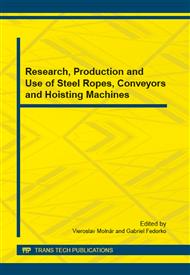p.97
p.102
p.108
p.114
p.119
p.125
p.130
p.135
p.142
Effect of Strength Parameters and the Structure of Steel Cord Conveyor Belts on Belt Puncture Resistance
Abstract:
Conveyor belts transporting rock material are getting worn out mainly as a consequence of punctures and cuts caused by impacts of rock lumps in the belt loading zone. To enhance the operational durability of conveyor belts multidirectional actions intended to lower the dynamic load of belts, to increase the belt impact resistance and to monitor the belt condition are undertaken. Some significant improvements can be achieved by decreasing the material fall height, by implementation of transported material slides in transfer chutes and shock absorbing belt supports as well as by reducing rock lump sizes. To avoid extensive wear belt monitoring methods are being developed, so that belt defect numbers, sizes, and locations can be identified [1]. Implementation of monitoring prevents sudden belt tear and enables rational belt management by repairing and regenerating belts in the optimum time. Laboratory research programmes aim at identifying the relation of the dynamic stress and the belt fatigue strength [2,3]. Investigations of the effect of strength parameters and the structure of steel cord conveyor belts on their puncture resistance are carried out since many years [4,5,6,7]. High puncture resistance of a conveyor belt is one of the main assessment criteria of its operational durability. Research work on the impact of belt top cover thickness, cover rubber properties and type of belt crosswise reinforcements on the belt puncture resistance was undertaken in the Laboratory of Belt Transportation (LBT) of Wroclaw University of Technology [8].
Info:
Periodical:
Pages:
119-124
Citation:
Online since:
October 2014
Keywords:
Price:
Сopyright:
© 2014 Trans Tech Publications Ltd. All Rights Reserved
Share:
Citation:


